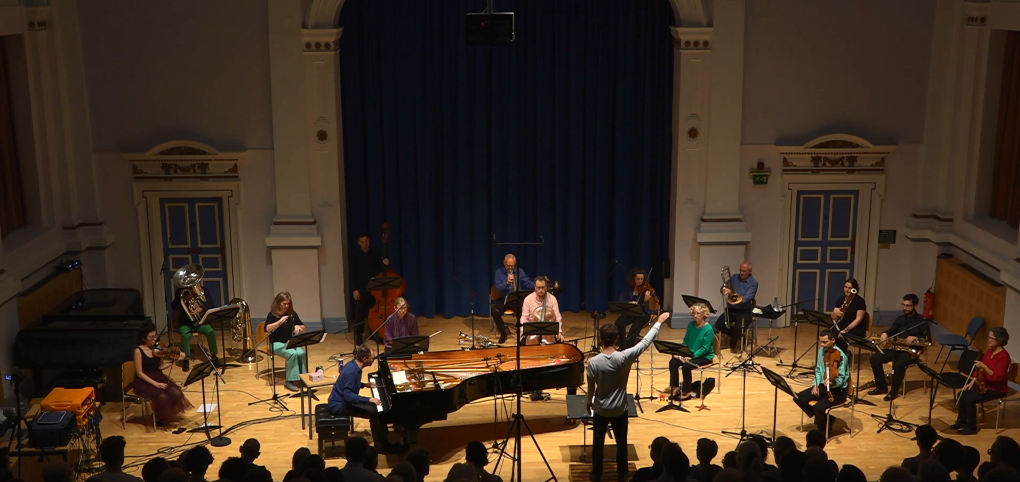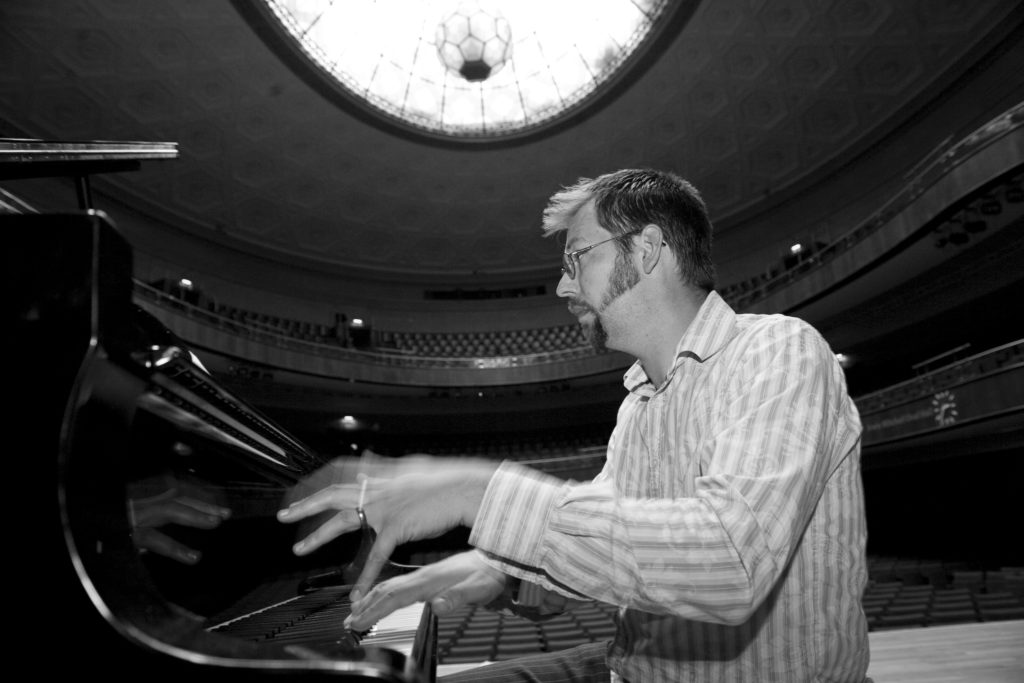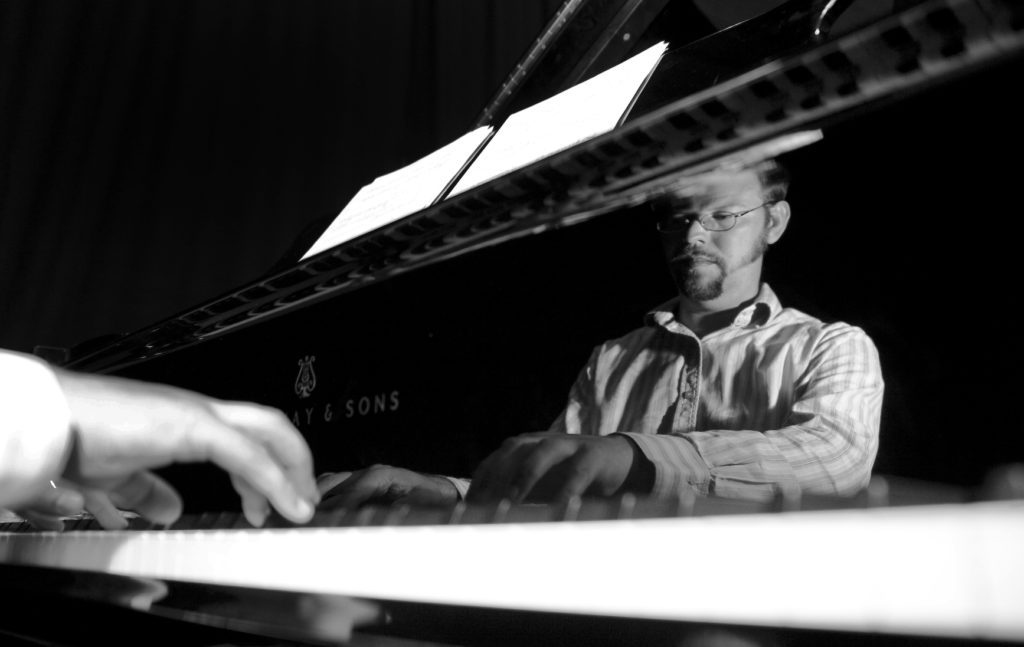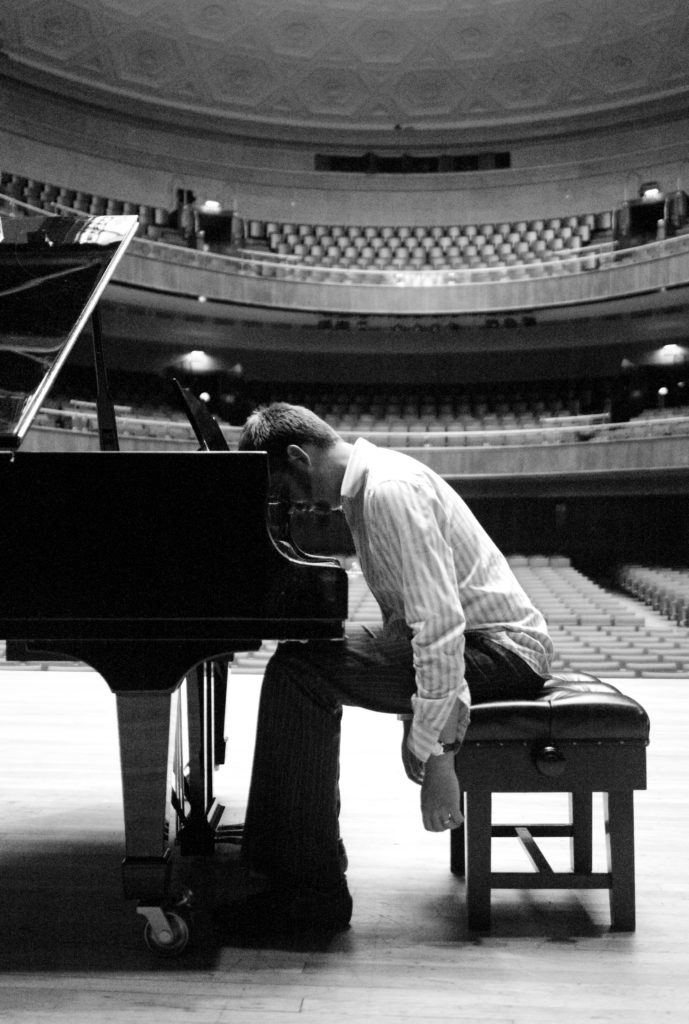CageConcert: An Interview with Philip Thomas

Interview: Philip Thomas Launches Cageconcert
By Christian Carey
Pianist Philip Thomas is a prolific artist. A member of Apartment House, he recently participated in their recording of Ryoko Akama’s compositions for Another Timbre. Also on Another Timbre is Thomas’s gargantuan CD set of piano music by Morton Feldman, which includes several previously unreleased pieces.
Two of the pianist’s other recent projects focus on other members of the New York School. His deep dive into Cage’s Concert for Piano (again with Apartment House) has resulted in a book, recording, and an interactive online project, Cageconcert (cageconcert.org) that also includes apps to work with segments of the piece and make one’s own versions. He has also released a recording of Christian Wolff’s piano music. Finally, Thomas has recorded a CD of composer-pianist Chris Burn’s work, including transcriptions of improvisations by the late guitarist (and author of one of the key books on improvisation) Derek Bailey. As the interview below demonstrates, Thomas’s performance and recording schedule shows no signs of let-up. (Note: Philip and I talked before the pandemic, so some of his future projects are now TBA).
How did you and Martin Iddon come to collaborate on a book about Cage’s Concert for Piano (1957-’58)? Were the book and recording in process before the website and apps were conceived or was the idea of multiple presentations part of the initial concept?
This goes back a long way! I had it in my thoughts that, having performed the piece a number of times, with Apartment House but also with others, including the Merce Cunningham Dance Company for the dance ‘Antic Meet’, it was a far richer piece than had perhaps history had credited it. It’s such a well-known piece, not least from its visual appearance, and its historic performance value has influenced what we think of as a Cage-ian performance practice. Plus the premiere performance and recording is notorious from its depiction on the Twenty-Fifth Retrospective Concert album. But I felt strongly that there was much that is not more widely known when digging a little deeper, both about the way it can be performed, about the graphic notations of the ‘Solo for Piano’, and about the instrumental and conductor parts. And I was aware that performance as both historical and contemporary practice has a lot to say about the music, not least because of the unusually long time one has to spend with the piano part in order to arrive at something which is playable. So I set to thinking about this as a major research project and immediately thought of Martin as being an ideal collaborator, particularly due to his brilliant book about Cage and Tudor, as well as his Darmstadt book. So over lunch in London one day we dreamt up the project, which over the following year developed and formed to include the book, the website and apps, as well as the involvement of Apartment House. Then there was the inevitable long wait until we found out our grant application was successful. The grant was for a 3-year project but inevitably aspects of that spill over into the months since – and I’ve just now finished the index for the book! The apps grew from a simple idea that we thought might be nice to a far more complex concept than any of us could have imagined, forming a vital part of the project. The team expanded to include two research assistants, Emily Payne and Chris Melen – Chris being the developer of the Solo for Piano app – with additional help from others, including Stuart Mellor who designed the Concert Player app.

As a pianist who specializes in experimental music, Concert for Piano seems like a natural work to explore from multiple vantage points. When did you first become acquainted with the piece, and what does it mean to you as an interpreter?
I’ve mostly played it with Apartment House. I think possibly the earliest occasion was in 2008 when I organised a 50th anniversary concert of the 25-year retrospective concert. My experience then was as it continues to be, that this is an exceptionally rich and lively piece, full of surprises, and one which is a total joy to perform – each moment is alive and fresh, and my experience as a performer is of being part of music being made, rather than something which is ‘re-played’. We don’t rehearse, everyone works on their own materials, and then it’s put together, so for everyone playing the experience is as new as it is for the audience. This is true of many pieces by Cage of course, but this piece seems to heighten those senses and the material is so exaggerated in its range here – noises, pitches, highs and lows, louds and softs, etc.
The website and apps provided detailed and varied material from Concert. Will you share with us some of the features you consider to be highlights?
There’s so much there, a few of my favourite things include:
Interviews with Apartment House – I love to hear the musicians of Apartment House talk about what they do. These interviews are brimming with insight. I especially like the films which combine their different insights, such as the ‘Performing the Concert’ film and the last 10 minutes of the conductor film.
Watching the films of our performances of the ‘Concert’ and also Christian Wolff’s ‘Resistance’ is a particular thrill, because, as I suggested above, there’s so much unknown in the performance itself that it’s great to get a stronger sense of the kinds of things the other musicians are doing.
This one is not yet on the website but will be appearing very soon – I have made a studio recording of the complete ‘Solo for Piano’, which has never been done. It’s completely different from the version I play with Apartment House – for this I recorded each notation individually, according to a space time measurement of 3 minutes per page, and then Alex Bonney has mapped them together like a patchwork quilt, to get a complete 3 hours and 9 minutes performance of the Solo. You can hear it now actually on the Concert Player app as it’s this recording which we use for the app.
For the uninitiated person finding this on the web, what do you think they apps will demonstrate to them?
I hope firstly that it’ll just be a great entry into the music – that this is music people play and love to play, and is really great to play, instead of perhaps either that it is too ‘far-out’ or obfuscatory, or, the flip-side, that it is entirely open and ‘free’! For users trying out the Solo for Piano app, I hope it’ll both be a great way of playing with the notations and their conditions for performance, to see what might be possible and conversely what is not possible with each, and to play with the multiple possibilities the notation offers; and that it will also be an aid to performance. Of course each pianist will want to try it out in their own way, but at the least I hope that for some notations this will be a time-saver, offering possibilities to randomly generate multiple outcomes and to print them off in usable formats. An obvious criticism of the app is that it removes the fun of working these things out yourself – I think it manages to keep the fun of playing with each notation, whilst cutting down on the work needed to write these things out. And we’ve been careful to always show where and how we’ve made interpretative decision when others might make other choices, so it’s clear that this is both a facility AND an interpretation.
And then the Concert player app is simply a delight to hear – there are 16,383 possible instrumental combinations of this piece, and we have a handful of recordings available. Clearly, a recording of a work such as this can only hint at the slightest possibility of how this piece may sound. But the app allows users to randomly generate or select combinations, plus select pages, their durations, their sequence, and then hear how that might sound. We’ve taken great care to ensure the space-time properties of the music are upheld (measuring by the pixel!) and so really this is a pretty accurate – no matter how inappropriate that word is to this piece!! – realisation. I still listen to it regularly and am surprised all the time by the combinations. It’s a thrill, so I hope people will just dive in.

You have been performing Morton Feldman’s music for over a quarter century. Still, the recording you did for Another Timbre last year was a mammoth undertaking. How long did it take to record? How do you keep so much detailed, long repertoire, with irregular repetitions, in your brain and fingers?
Somehow it didn’t feel like a mammoth task, more like a real pleasure to play these pieces again. Perhaps surprisingly, I didn’t feel any kind of pressure to give a ‘definitive’ statement on the music – my performances on disc just happen to be a representation of how I play this music today, after many years of thinking about and playing it. If I were to record it all again in 10 years it may be quite different, who knows? It was though a particular pleasure to discover a few pieces that I hadn’t played before, namely the unpublished works I explored at the Sacher Foundation in Basel, and the transcription I made of the Lipton film music.
I recorded the music over a period of about 2 years, in different sessions. It’s funny how the music at times just sticks in terms of fingering, rhythmic detail, whilst at other times what should be very familiar to me still seems strange. Certainly, whereas I thought this project might draw a line in the sand for me – no more Feldman! – I feel it’s done the opposite, opened up more possibilities, more ways of thinking about the music. In particular, Triadic Memories, which I’ve probably played more often than any other single piece of music, changed a great deal for me in preparation for the recording and what I thought I knew now feels more experimental, more curious, than ever. There’s a part of me that sometimes tries to avoid Feldman’s music – it’s almost too gorgeous at times, and I need to find something else, something of rougher hue, but those chords keep pulling me back! Thankfully, there’s so much more to the music than just beautiful sonorities, and in particular the music’s form and narrative feels to me to be so strikingly original.
Are there surprises among the previously unrecorded pieces?
Certainly, the addition of struck drum and glass to the Feldman sound is pretty surprising, bringing to mind much more the 1940s music by Cage, and here included as part of a set of three pieces composed for the dance. In fact there’s a surprising number of pieces composed for dance collaborations, not just for Cunningham, but also for Merle Mersicano, as Ryan Dohoney has written about in considerable detail recently. One of these is Figure of Memory which sounds nothing like Feldman and more like some kind of sketch of a Satie piece, consisting simply of repetitions of three short phrases.
Another recent release is of music by Chris Burn, including a transcription of an improvisation by Derek Bailey. How does that translate to the piano?
Well Chris is a wonderful wonderful composer, and a brilliant pianist and improviser. And so he is fully aware of the slightly perverse nature of what he was doing in writing these pieces, not least as someone who used to play with Bailey. But these pieces are not just really lovely pieces of music, but they also reveal something about Chris and how he hears and thinks of music, as well as being revealing of Bailey’s own work, and in particular of his love of Webern and his close attention to pitch. So when the guitar-ness of the pieces is removed a different side to Bailey’s music is revealed which is simply different but to my ears no less remarkable.
As if 2019 weren’t busy enough for you, a compendium of Christian Wolff’s piano music was released on Sub Rosa. In the notes you say that “In all my performances of Wolff’s music, I aim for interpretations that both interest and surprise me, allowing the notations to lead me to new ways of playing and thinking about music, whilst at
the same time trying to lead the notations toward the unexpected.” When discussing the piano music with Wolff, what were some insights he offered? What piece will most likely surprise listeners?
The recent double disc follows on from an earlier three-disc set, and hopefully precedes another three-disc set to follow. Christian’s music is, when it comes down to it, the music I feel closest to. I love the potential for change, for surprise, for play. On the whole I tend not to ‘collaborate’ with composers (I trust them to do what they do well and then it’s over to me) and so I love the moment when I begin a new piece, I put it up on the piano and I start to think ‘ok so what am I going to do with this’. This is where I am at my most creative, and Christian’s music works especially well to that effect. I’ve never asked him for his approval of what I do and most often he doesn’t hear my interpretations until after I’ve performed or recorded it. Though the very first time we met, in 2002, I played ‘Bread and Roses’ to him, waited for his response, and learnt fairly quickly that his typical response was ‘Sure!’. He tends not to validate not to denigrate peoples’ performances of his music and I appreciate that. He doesn’t want to say ‘yes, this is how it should be played’ preferring instead for the individuality of the player to find new solutions, new ways of playing. And so I do hope with each performance I give of his music that I might offer something that would surprise him, that might suggest possibilities in his music which he’d not considered.
In this recent set I’ve included a few pieces which are not published, so that surprised him too! So three variations on Satie, pieces he composed for John Tilbury, which he never quite convinced himself as worth publishing but hopefully he’s convinced now they’re out on disc – they’re wonderfully eccentric pieces. Also his Incidental Music, which he has played and recorded (wonderfully, on Mode) but which he’d not heard anyone else perform. He was delighted, so that’s great. And for anyone familiar with Wolff’s music I hope that my playing brings both recognition and surprise too.

What will be your next recording/recital? What will Apartment House be up to in 2020?
Next concert, in Cambridge in April, features a brand-new piece that Toronto-based composer Allison Cameron is writing for me, which I’m delighted about. And Simon Reynell’s always dreaming up new ideas and introducing me to younger composers and I’m always happy to play a small part in that project. And as a result of the Feldman release we’ve been able to commission one of my very favourite composers, Martin Arnold, to write a large-scale new piece for me. But that won’t be for a while. Lots of ideas, lots of pieces I want to play, but actually I’m hoping for a bit of a quieter year this year!
(For more, consult Philip Thomas’s website.)
Christian Carey is a composer, performer, musicologist, and writer. His work has been published in Perspectives of New Music, Intégral, Open Space, Tempo, Musical America, Time Out New York, Signal to Noise, Early Music America, Sequenza 21, Pop Matters, All About Jazz, and NewMusicBox. Carey’s research on narrativity in late music by Elliott Carter, presented at IRCAM in Paris on the composer’s 100th birthday, appears in Hommage à Elliott Carter (Editions Delatour). He is Associate Professor of Composition, History, and Theory at Westminster Choir College in Princeton, New Jersey.